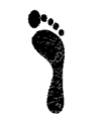Check yourself before you wreck yourself!
With all the walking and running that’s going on at the moment, it’s important to ensure you’re wearing the right type of footwear.
A simple way to check if you have any specific requirements when buying runners is to test yourself at home. This test serves as a helpful guideline as to the type of motion control you may benefit from when purchasing runners. All you require to do this test is use some brown paper, water and your two feet!
Step 1) Pour a thin layer of water into a shallow pan.
Step 2) Wet the sole of your foot.
Step 3) Step onto the brown paper (this can even be a shopping bag).
Step 4) Step off and look down…
Observe the shape of the footprint that has been left behind and match it as closely as possible to one of these imprints below:
Neutral
As a normal pronator (how much your foot rolls in when hitting the ground), you can wear just about any shoe, but may be best suited to a stability shoe that provides moderate arch support (or medial stability). Lightweight individuals with normal arches may prefer neutral cushioned shoes without any added support
Flat foot
If you see almost your entire footprint, you have a flat foot, which means you’re probably an overpronator. Your arch collapses inward too much, resulting in excessive foot motion and increasing your risk of injuries. You may benefit from either stability shoes, to reduce pronation for mild to moderate overpronators, or motion control shoes, which have firmer support devices and are best for severe overpronators or bow-legged runners.
High Arch
If you see just your heel, the ball of your foot, and a thin line on the outside of your foot, you have a high arch. This means you’re likely an under pronator, or supinator, which can result in too much shock traveling up your legs, since your arch doesn’t collapse enough to absorb forces effectively. Under pronators are best suited to neutral-cushioned shoes because they need a softer midsole to encourage pronation. It’s vital that an under pronator’s shoes have no added stability devices to reduce or control pronation, the way a stability or motion-control shoe would.


